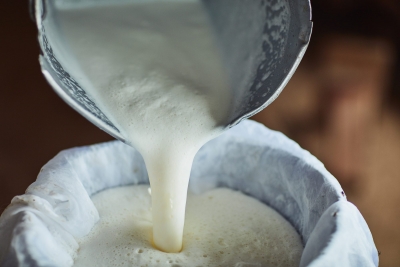
Mmm! When it’s hot, cheese is stringy and gooey. You know cheese is made with milk. But how does milk get to the cheese?
In a cheese factory, cheese makers pour milk into big tanks. They heat the milk and add something called a “starter” to make the milk turn sour.
Next, they add an enzyme called rennin. The rennin makes the milk thicken and harden. The milk turns into a thick solid called curds and a thin liquid called whey.
The curds are heated until they are firm and the whey is drained off. Machines salt the curd. It is then cut up and pressed into moulds. Most kinds of cheese are stored at a certain temperature for a period of time. This is called aging. Some kinds of cheese are aged for many months to get just the right flavor. When it has aged, the cheese is sent to the shop.
Add a couple of 2 spoonfuls of lemon juice and sugar to a half cup of whole milk. Stir. Let it stand for one minute. Now stir again. What happened? Did it get thicker?
Lemon juice is an acid. It sours the milk. But it also reacts with the fats in the milk. The milk thickens, just as it does when making cheese. The sugar speeds up this reaction.
How was cheese discovered? There is a legend about an Arab traveller accidentally making the first cheese. The legend says that, over 4,000 years ago, this traveller made a trip across the desert. He used a pouch made from a sheep’s stomach to carry milk on the trip. Using animal parts like this was common then.
After a long, hot day, the milk turned into a watery, lumpy mixture. Rennin is found in the stomach of some animals. The desert heat and the rennin made the milk separate into curds and whey. Because the traveller was hungry, he ate the curds and whey and found it delicious.
Picture Credit : Google




